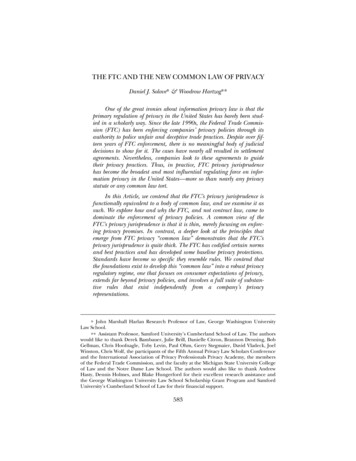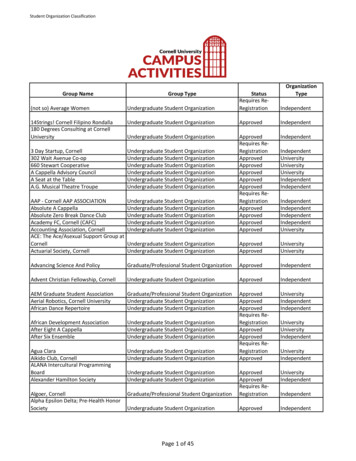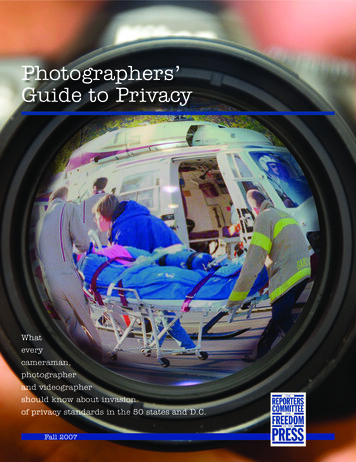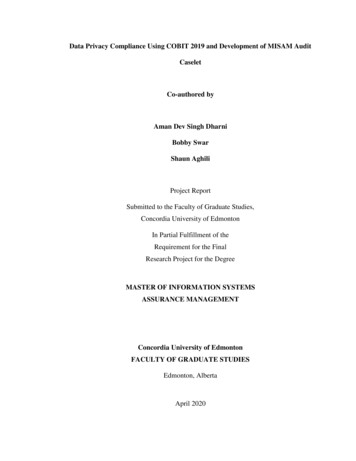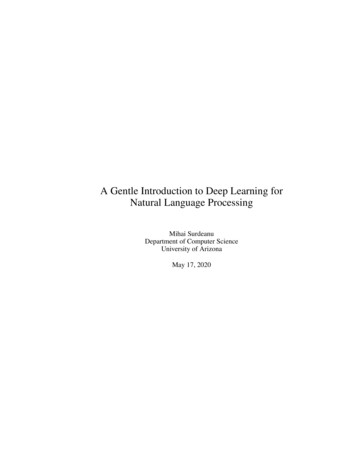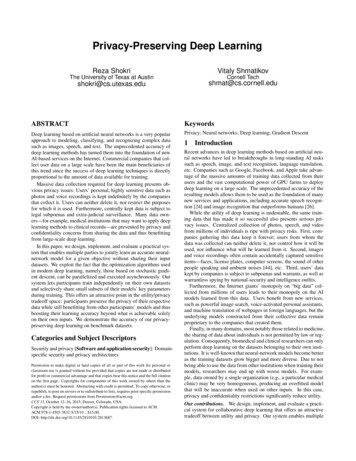
Transcription
Privacy-Preserving Deep LearningReza ShokriVitaly ShmatikovThe University of Texas at AustinCornell CTKeywordsDeep learning based on artificial neural networks is a very popularapproach to modeling, classifying, and recognizing complex datasuch as images, speech, and text. The unprecedented accuracy ofdeep learning methods has turned them into the foundation of newAI-based services on the Internet. Commercial companies that collect user data on a large scale have been the main beneficiaries ofthis trend since the success of deep learning techniques is directlyproportional to the amount of data available for training.Massive data collection required for deep learning presents obvious privacy issues. Users’ personal, highly sensitive data such asphotos and voice recordings is kept indefinitely by the companiesthat collect it. Users can neither delete it, nor restrict the purposesfor which it is used. Furthermore, centrally kept data is subject tolegal subpoenas and extra-judicial surveillance. Many data owners—for example, medical institutions that may want to apply deeplearning methods to clinical records—are prevented by privacy andconfidentiality concerns from sharing the data and thus benefittingfrom large-scale deep learning.In this paper, we design, implement, and evaluate a practical system that enables multiple parties to jointly learn an accurate neuralnetwork model for a given objective without sharing their inputdatasets. We exploit the fact that the optimization algorithms usedin modern deep learning, namely, those based on stochastic gradient descent, can be parallelized and executed asynchronously. Oursystem lets participants train independently on their own datasetsand selectively share small subsets of their models’ key parametersduring training. This offers an attractive point in the utility/privacytradeoff space: participants preserve the privacy of their respectivedata while still benefitting from other participants’ models and thusboosting their learning accuracy beyond what is achievable solelyon their own inputs. We demonstrate the accuracy of our privacypreserving deep learning on benchmark datasets.Privacy; Neural networks; Deep learning; Gradient DescentCategories and Subject DescriptorsSecurity and privacy [Software and application security]: Domainspecific security and privacy architecturesPermission to make digital or hard copies of all or part of this work for personal orclassroom use is granted without fee provided that copies are not made or distributedfor profit or commercial advantage and that copies bear this notice and the full citationon the first page. Copyrights for components of this work owned by others than theauthor(s) must be honored. Abstracting with credit is permitted. To copy otherwise, orrepublish, to post on servers or to redistribute to lists, requires prior specific permissionand/or a fee. Request permissions from Permissions@acm.org.CCS’15, October 12–16, 2015, Denver, Colorado, USA.Copyright is held by the owner/author(s). Publication rights licensed to ACM.ACM 978-1-4503-3832-5/15/10 . 15.00.DOI: ctionRecent advances in deep learning methods based on artificial neural networks have led to breakthroughs in long-standing AI taskssuch as speech, image, and text recognition, language translation,etc. Companies such as Google, Facebook, and Apple take advantage of the massive amounts of training data collected from theirusers and the vast computational power of GPU farms to deploydeep learning on a large scale. The unprecedented accuracy of theresulting models allows them to be used as the foundation of manynew services and applications, including accurate speech recognition [24] and image recognition that outperforms humans [26].While the utility of deep learning is undeniable, the same training data that has made it so successful also presents serious privacy issues. Centralized collection of photos, speech, and videofrom millions of individuals is ripe with privacy risks. First, companies gathering this data keep it forever; users from whom thedata was collected can neither delete it, nor control how it will beused, nor influence what will be learned from it. Second, imagesand voice recordings often contain accidentally captured sensitiveitems—faces, license plates, computer screens, the sound of otherpeople speaking and ambient noises [44], etc. Third, users’ datakept by companies is subject to subpoenas and warrants, as well aswarrantless spying by national-security and intelligence outfits.Furthermore, the Internet giants’ monopoly on “big data” collected from millions of users leads to their monopoly on the AImodels learned from this data. Users benefit from new services,such as powerful image search, voice-activated personal assistants,and machine translation of webpages in foreign languages, but theunderlying models constructed from their collective data remainproprietary to the companies that created them.Finally, in many domains, most notably those related to medicine,the sharing of data about individuals is not permitted by law or regulation. Consequently, biomedical and clinical researchers can onlyperform deep learning on the datasets belonging to their own institutions. It is well-known that neural-network models become betteras the training datasets grow bigger and more diverse. Due to notbeing able to use the data from other institutions when training theirmodels, researchers may end up with worse models. For example, data owned by a single organization (e.g., a particular medicalclinic) may be very homogeneous, producing an overfitted modelthat will be inaccurate when used on other inputs. In this case,privacy and confidentiality restrictions significantly reduce utility.Our contributions. We design, implement, and evaluate a practical system for collaborative deep learning that offers an attractivetradeoff between utility and privacy. Our system enables multiple
participants to learn neural-network models on their own inputs,without sharing these inputs but benefitting from other participantswho are concurrently learning similar models.Our key technical innovation is the selective sharing of model parameters during training. This parameter sharing, interleaved withlocal parameter updates during stochastic gradient descent, allowsparticipants to benefit from other participants’ models without explicit sharing of training inputs. Our approach is independent of thespecific algorithm used to construct a model for a particular task.Therefore, it can easily accommodate future advances in neuralnetwork training without changing the core protocols.Selective parameter sharing is effective because stochastic gradient descent algorithms underlying modern neural-network trainingcan be parallelized and run asynchronously. They are robust to unreliable parameter updates, race conditions, participants droppingout, etc. Updating a small fraction of parameters with values obtained from other participants allows each participant to avoid local minima in the process of finding optimal parameters. Parametersharing can be tuned to control the tradeoff between the amount ofinformation exchanged and the accuracy of the resulting models.We experimentally evaluate our system on two datasets, MNISTand SVHN, used as benchmarks for image classification algorithms.The accuracy of the models produced by the distributed participants in our system is close to the centralized, privacy-violatingcase where a single party holds the entire dataset and uses it to trainthe model. For the MNIST dataset, we obtain 99.14% accuracy(respectively, 98.71%) when participants share 10% (respectively,1%) of their parameters. By comparison, the maximum accuracyis 99.17% for the centralized, privacy-violating model and 93.16%for the non-collaborative models learned by participants individually. For the SVHN dataset, we achieve 93.12% (89.86%) accuracywhen participants share 10% (1%) of their parameters. By comparison, the maximum accuracy is 92.99% for the centralized, privacyviolating model and 81.82% for the non-collaborative models.Even without additional protections, our system already achievesmuch stronger privacy, with negligible utility loss, than any existingapproach. Instead of directly revealing all training data, the onlyleakage in our system is indirect, via a small fraction of neuralnetwork parameters. To minimize even this leakage, we show howto apply differential privacy to parameter updates using the sparsevector technique, thus mitigating privacy loss due to both parameter selection (i.e., choosing which parameters to share) and sharedparameter values. We then quantitatively measure the tradeoff between accuracy and privacy.2Related Work2.1Deep learningDeep learning is the process of learning nonlinear features andfunctions from complex data. Surveys of deep-learning architectures, algorithms, and applications can be found in [5, 16]. Deeplearning has been shown to outperform traditional techniques forspeech recognition [23,24,27], image recognition [30,45], and facedetection [48]. A deep-learning architecture based on a new typeof rectifier activation functions is claimed to outperform humanswhen recognizing images from the ImageNet dataset [26].Deep learning has shown promise for analyzing complex biomedical data related to cancer [13, 22, 32] and genetics [15, 56]. Thetraining data used to build these models is especially sensitive fromthe privacy perspective, underscoring the need for privacy-preservingdeep learning methods.Our work is inspired by recent advances in parallelizing deeplearning, in particular parallelizing stochastic gradient descent onGPU/CPU clusters [14], as well as other techniques for distributing computation during neural-network training [1, 39, 59]. Thesetechniques, however, are not concerned with privacy of the trainingdata and all assume that a single entity controls the training.2.2Privacy in machine learningThe existing literature on privacy protection in machine learningmostly targets conventional machine learning algorithms, as opposed to deep learning, and addresses three objectives: privacy ofthe data used for learning a model or as input to an existing model,privacy of the model, and privacy of the model’s output.Techniques based on secure multi-party computation (SMC) canhelp protect intermediate steps of the computation when multipleparties perform collaborative machine learning on their proprietaryinputs. SMC has been used for learning decision trees [33], linear regression functions [17], association rules [50], Naive Bayesclassifiers [51], and k-means clustering [28]. In general, SMC techniques impose non-trivial performance overheads and their application to privacy-preserving deep learning remains an open problem.Techniques that protect privacy of the model include privacypreserving probabilistic inference [38], privacy-preserving speakeridentification [36], and computing on encrypted data [3, 6, 55]. Bycontrast, our objective is to collaboratively train a neural networkthat can be used privately and independently by each participant.Differential privacy [19] is a popular approach to privacy-preserving machine learning. It has been applied to boosting [21], principal component analysis [10], linear and logistic regression [8, 57],support vector machines [41], risk minimization [9, 53], and continuous data processing [43]. Recent results show that a noisy variant of stochastic gradient descent achieves optimal error for minimizing Lipschitz convex functions over 2 -bounded sets [4], andthat randomized “dropout,” used to prevent overfitting, cal alsostrengthen the privacy guarantee in a simple 1-layer neural network [29]. To the best of our knowledge, none of the previous workaddressed the problem of collaborative deep learning with multipleparticipants using distributed stochastic gradient descent.Aggregation of independently trained neural networks using differential privacy and secure multi-party computation is suggestedin [37]. Unfortunately, averaging neural-network parameters doesnot necessarily result in a better model.Unlike previously proposed techniques, our system achieves allthree privacy objectives in the context of collaborative neural-networktraining: it protects privacy of the training data, enables participantsto control the learning objective and how much to reveal about theirindividual models, and lets them apply the jointly learned model totheir own inputs without revealing the inputs or the outputs. Oursystem achieves this at a much lower performance cost than cryptographic techniques such as secure multi-party computation or homomorphic encryption and is suitable for deployment in modernlarge-scale deep learning.3Deep LearningDeep learning aims to extract complex features from high-dimensional data and use them to build a model that relates inputs to outputs(e.g., classes). Deep learning architectures are usually constructedas multi-layer networks so that more abstract features are computedas nonlinear functions of lower-level features. We mainly focuson supervised learning, where the training inputs are labeled withcorrect classes, but in principle our approach can also be used forunsupervised, privacy-preserving learning, too.Multi-layer neural networks are the most common form of deeplearning architectures. Figure 1 shows a typical neural networkwith two hidden layers. Each node in the network models a neu-
y1y2individual parameters are computed from the neurons’ activationvalues and their contribution to the error.W4W3W2x1x2x3Figure 1: A neural network with two hidden layers. Black circles representthe bias nodes. Matrices Wk contain the weights used in computing theactivation functions at each layer k.ron. In a typical multi-layer network, each neuron receives the output of the neurons in the previous layer plus a bias signal froma special neuron that emits 1. It then computes a weighted average of its inputs, referred to as the total input. The output of theneuron is computed by applying a nonlinear activation function tothe total input value. The output vector of neurons in layer k isak f (Wk ak 1 ), where f is an activation function and Wk isthe weight matrix that determines the contribution of each inputsignal. Examples of activation functions are hyperbolic tangentf (z) (e2z 1)(e2z 1) 1 , sigmoid f (z) (1 e z ) 1 ,rectifier f (z) max(0, z), and softplus f (z) log(1 ez ). Ifthe neural network is used to classify input data into a finite number of classes (each represented by a distinct output neuron), theactivation functionP in the last layer is usually a softmax functionf (zj ) ezj · ( k ezk ) 1 , j. In this case, the output of eachneuron j in the last layer is the relative score or probability that theinput belongs to class j.In general, the values computed in higher layers represent moreabstract features of the data. The first layer is composed of the rawfeatures extracted from the data, e.g., the intensity of colors in eachpixel in an image or the frequency of each word in a document.The outputs of the last layer correspond to the abstract answersproduced by the model. If the neural network is used for classification, these abstract features also represent the relation betweeninput and output. The nonlinear function f and the weight matricesdetermine the features that are extracted at each layer. The mainchallenge in deep learning is to automatically learn from trainingdata the values of the parameters (weight matrices) that maximizethe objective of the neural network (e.g., classification accuracy).Learning network parameters using gradient descent. Learning the parameters of a neural network is a nonlinear optimizationproblem. In supervised learning, the objective function is the output of the neural network. The algorithms that are used to solvethis problem are typically variants of gradient descent [2]. Simply put, gradient descent starts at a random point (set of parametersfor the neural network), then, at each step, computes the gradientof the nonlinear function being optimized and updates the parameters so as to decrease the gradient. This process continues until thealgorithm converges to a local optimum.In a neural network, the gradient of each weight parameter iscomputed through feed-forward and back-propagation procedures.Feed-forward sequentially computes the output of the network giventhe input data and then calculates the error, i.e., the difference between this output and the true value of the function. Back-propagationpropagates this error back through the network and computes thecontribution of each neuron to the total error. The gradients ofStochastic gradient descent (SGD). The gradients of the parameters can be averaged over all available data. This algorithm, knownas batch gradient descent, is not efficient, especially if learning ona large dataset. Stochastic gradient descent (SGD) is a drastic simplification which computes the gradient over an extremely smallsubset (mini-batch) of the whole dataset [58]. In the simplest case,corresponding to maximum stochasticity, one data sample is selected at random in each optimization step.Let w be the flattened vector of all parameters in a neural network, composed of Wk , k. Let E be the error function, i.e., thedifference between the true value of the objective function and thecomputed output of the network. E can be based on L2 norm orcross entropy [34]. The back-propagation algorithm computes thepartial derivative of E with respect to each parameter in w and updates the parameter so as to reduce its gradient. The update rule ofstochastic gradient descent for a parameter wj iswj : wj α Ei wj(1)where α is the learning rate and Ei is computed over the minibatch i. We refer to one full iteration over all available input dataas an epoch.Note that each parameter in vector w is updated independentlyfrom other parameters. We will rely on this property when designing our system for privacy-preserving, collaborative stochasticgradient descent in the rest of this paper. Some techniques set thelearning rate adaptively [18] but still preserve this independence.4Distributed Selective SGDThe core of our approach is a distributed, collaborative deep learning protocol that relies upon the following observations: (i) updates to different parameters during gradient descent are inherentlyindependent, (ii) different training datasets contribute to differentparameters, and (iii) different features do not contribute equally tothe objective function. Our Selective Stochastic Gradient Descent(Selective SGD or SSGD) protocol achieves comparable accuracyto conventional SGD but involves updating 1 or even 2 orders ofmagnitude fewer parameters in each learning iteration.Selective parameter update. The main intuition behind selectiveparameter update is that during SGD, some parameters contributemuch more to the neural network’s objective function and thus undergo much bigger updates during a given iteration of training. Thegradient value depends on the training sample (mini-batch) andvaries from one sample to another. Moreover, some features ofthe input data are more important than others, and the parametersthat help compute these features are more crucial in the process oflearning and undergo bigger changes.In selective SGD, the learner chooses a fraction of parameters tobe updated at each iteration. This selection can be completely random, but a smart strategy is to select the parameters whose currentvalues are farther away from their local optima, i.e., those that havea larger gradient. For each training sample i, compute the partial Eifor all parameters wj as in SGD. Let S be the inderivative wj Eidices of θ parameters with the largest wvalues. Finally, updatejthe parameter vector wS in the same way as in (1), so the parameters not in S remain unchanged. We refer to the ratio of θ over thetotal number of parameters as the parameter selection rate.Distributed collaborative learning. Distributed selective SGDassumes two or more participants training independently and concurrently. After each round of local training, participants asyn-
αθd , θuγτglobal parametersdownload thelatest values ofmost-updatedparameters upload gradient ofselected parametersand add them toglobal parameters selected parametersselected parametersselected gradients selected parameterslocal parameters and gradientsSGDSGDlocal training datasetlocal training datasetTable 1: List of meta-parametersChoose initial parameters w(i) and learning rate α.Repeat until an approximate minimum is obtained:selected gradientsselected gradientslocal parameters and gradients Learning rate of stochastic gradient descentFraction of parameters selected for download and uploadBound on gradient values shared with other participantsThreshold for gradient selection1. Download θd w(i) parameters from server and replace thecorresponding local parameters. 2. Run SGD on the local dataset and update the local parametersw(i) according to (1).3. Compute gradient vector w(i) which is the vector ofchanges in all local parameters due to SGD.local parameters and gradients(i)4. Upload wS to the parameter server, where S is the setof indices of at most θu w(i) gradients that are selectedaccording to one of the following criteria:SGDlocal training dataset largest values: Sort gradients in w(i) and upload θufraction of them, starting from the biggest. random with threshold: Randomly subsample the gradients whose value is above threshold τ .Figure 2: High-level architecture of our deep learning system. An abstractmodel of the parameter server, which maintains global values for the parameters, is depicted at the top.The selection criterion is fixed for the entire training.Figure 3: Pseudocode of DSSGD for participant i.chronously share with each other the gradients they computed forsome of the parameters. Each participant fully controls which gradients to share and how often. The sum of all gradients computedfor a given parameter determines the magnitude of the global descent towards the parameter’s local optima (“local” here refers tothe space of parameter values and does not mean being limited to asingle participant). Participants thus benefit from each other’s training data—without actually seeing this data!—and produce muchmore accurate models that they would have been able to learn inisolation, limited to their own training data.Participants can exchange gradients directly, or via a trusted central server, or even use secure multi-party computation to exchangethem “obliviously,” emulating the functionality of a trusted serverthat hides the origin of each update. For the purposes of this discussion, we assume an abstraction of a central server to which participants asynchronously upload the gradients. The server adds allgradients to the value of the corresponding parameter. Each participant downloads a subset of the parameters from the server anduses them to update his local model. The download criterion for agiven parameter can be the frequency or recency of updates or themoving average of gradients added to that parameter.5System Architecture5.1OverviewFigure 2 illustrates the main components and protocols of our collaborative deep learning system. We assume that there are N participants, each of which has a local private dataset available fortraining. All participants agree in advance on a common networkarchitecture and common learning objective. We assume the existence of a parameter server which is responsible for maintainingthe latest values of parameters available to all parties. This parameter server is an abstraction, which can be implemented by an actualserver or emulated by a distributed system.Each participant initializes the parameters and then runs the training on his own dataset. The system includes a parameter exchangeprotocol that enables participants to upload the gradients of selectedneural-network parameters to the parameter server and downloadthe latest parameter values at each local SGD epoch. This allowsparticipants to (i) independently converge to a set of parametersand, critically, (ii) avoid overfitting these parameters to a singleparticipant’s local training dataset. Once the network is trained,each participant can independently and privately evaluate it on newdata, without interacting with other participants.In the following, we describe all components of our system indetail. Table 1 lists the meta-parameters of our system. Theseparameters control the collaborative learning process, as opposedto the actual neural-network parameters that are being learned.5.2Local trainingWe assume that each participant i maintains a local vector of neuralnetwork parameters, w(i) . The parameter server maintains a separate parameter vector w(global) . Each participant can initialize hislocal parameters randomly or by downloading their latest valuesfrom the parameter server.Each participant then trains the neural network using the standard SGD algorithm, iterating over his local training data over manyepochs. There need not be any coordination between different participants during their local training. They influence each other’straining indirectly, via the parameter server.Figure 3 presents the pseudocode of the distributed selective SGD(DSSGD) algorithm. DSSGD is run independently by every participant and consists of five steps in each learning epoch. First, theparticipant downloads a θd fraction of parameters from the serverand overwrites his local parameters with the downloaded values.He then runs one epoch of SGD training on his local dataset. Thistraining can be done on a sequence of mini-batches; a mini-batchis the set of randomly chosen training data points of size M .
In the third step, the participant computes w(i) , the vector ofchanges in all parameters in step 2, i.e., for every parameter j, the(i)(i)old wj value is subtracted from the new wj value after the latestChoose initial global parameters w(global) .Set vector stat to all zero.E VENT: A participant uploads gradients wS .(i)epoch of local SGD. We refer to wj as the gradient of parameterj over one epoch of local SGD.1 w(i) values reflect how mucheach parameter has to change to more accurately model the localdataset of the ith participant. This information is exactly what otherparticipants need to incorporate in order to avoid overfitting.There are several ways to choose which gradients to share at theend of each local epoch. Participants need to agree on the criterionand use it consistently throughout DSSGD. We assume that at mostθu fraction of parameters can be selected for upload at each epoch.We consider two selection criteria. The first method is to selectexactly θu fraction of values, picking big values that significantlycontribute to the gradient descent algorithm. The other method isto select a random subset of values that are larger than thresholdτ . Since the number of gradients that are greater than τ may besmaller than the θu fraction of parameters, fewer gradients will beshared. This might slow down convergence but this selection criterion is closer to the sparse vector technique that we use whenextending our system with differential privacy (see Section 7.2).Before uploading the selected gradients w(i) , their values aretruncated into the [ γ, γ] range. To prevent these values from leaking too much information about the training data, random noise canalso be added as described in Section 7. In short, the participant updates w(i) with bound( w(i) , γ) and adds some random noiseto it before uploading it. In Section 7, we explain how to set therange and randomness parameters and discuss their effect on SGD.5.3Parameter serverThe parameter server initializes the parameter vector w(global) andthen handles the participants’ upload and download requests. Figure 4 shows the server’s pseudocode. When someone uploads gradients, the server adds the uploaded wj value to the corresponding global parameters and updates the meta-data and the updatecounter statj for each parameter j. To increase the weight of morerecently updated parameters, the server can periodically multiplythe counter by a decay factor β, i.e., stat : β · stat. Thesestatistics are used during download, when participants obtain fromthe server the latest values of the parameters with the largest statvalues. Each participant decides what fraction of these parametersto download by setting θd .5.4Why distributed selective SGD worksOur distributed SSGD achieves achieving almost the same accuracyas conventional, privacy-violating SGD for the same reason whySGD is successful in general: stochasticity of the learning process.Updating local parameters with a subset of global parameters during training increases the stochasticity of local SGD. This plays anessential role in preventing local SGD from overfitting to its smalllocal dataset. When training alone, each participant is susceptibleto falling into local optima. Overwriting locally learned parameters with values learned by other participants, who train on different datasets, helps each participant escape local optima and enablesthem to explore other values, resulting in more accurate models.Our distributed SSGD does not make any assumptions aboutwhich parameters need to be updated by other participants, norabout the update rate. Some participants may undergo a highernumber of updates, due to better computation and throughput ca1Usually gradient refers to the change in a parameter after a single mini-batch training, but here we generalize it to one epoch oftraining over several mini-batches. For all j S:– Set w(global) : w(global) wj– Set statj : statj 1E VENT: A participant downloads θ parameters. Sort stat, and let Iθ be the set of indices for stat elementswith largest va
2.1Deep learning Deep learning is the process of learning nonlinear features and functions from complex data. Surveys of deep-learning architec-tures, algorithms, and applications can be found in [5,16]. Deep learning has been shown to outperform traditional techniques for speech recognition [23,24,27], image recognition [30,45], and face .

